What are humanoid robots and why are they so fascinating? Humanoid robots are machines designed to resemble and act like humans. Robots can mimic human expressions, interactions, and movements with their head, torso, two arms, and two legs.
These robots have advanced cameras, sensors, and artificial intelligence that help them do many different tasks. This technological marvel is pushing the boundaries of what's possible, blending the lines between humans and machines.
This article discusses the latest developments in humanoid robotics. It also showcases the top models in the industry. Additionally, it examines the impact of these robots on society and industry. Additionally, we tackle the challenges and ethical dilemmasthat surface with the development and usage of humanoid robots.
This article provides interesting information about humanoid robotics. If you enjoy science fiction or are curious about robots, you may find it particularly intriguing. It is a great opportunity to learn more about this fascinating field.
Defining the Modern Humanoid Robot
Before we explore the latest advancements in humanoid robotics, it's essential to understand what constitutes a modern humanoid robot. Wikipedia defines a humanoid robot as one that mirrors the human form. This design may serve various purposes, from interacting with human-centric tools and environments to studying bipedal movement, or even beyond.
Typically, humanoid robots are equipped with a torso, a head, two arms, and two legs. However, some may only replicate a portion of the human body. The goal is often to achieve functional, experimental, or other specific objectives through their design.
As highlighted by TechCrunch, the idea of humanoid automation precedes even the term 'robot.' The sudden surge in discussion around humanoid robots is due to technological advancements finally meeting the vision of creating robots that can perform a wide range of tasks and functions.
Thanks to progress in cameras, sensors, artificial intelligence, and machine learning, humanoid robots can now execute more complex actions including walking, running, jumping, dancing, playing instruments, and expressing emotions.
Built In recognizes several leading humanoid robots currently in operation, such as Sophia, Atlas, Digit, and Pepper. These robots boast human-like features like facial expressions, voice recognition, natural language processing, and social skills, enabling them to learn from their surroundings and adapt to new scenarios.
Some are designed for specific uses, such as service, entertainment, or research, while others aim to be jack-of-all-trades, capable of performing any task a human can.
However, designing humanoid robots is a complex endeavor, as Into Robotics notes. It necessitates a multidisciplinary approach combining engineering, computer science, and aspects of human anatomy to create machines that not only resemble but also move like humans.
The process is fraught with challenges and raises ethical questions regarding safety, reliability, autonomy, and the societal impact of humanoid robots. These are critical issues we'll delve into in further sections of this article.
The Front-Runners of Humanoid Innovation
Humanoid robots have been evolving rapidly in recent years, thanks to the advances in artificial intelligence, sensors, actuators, and materials. In this section, we will introduce some of the most prominent examples of humanoid innovation, their features, and their applications.
ASIMO by Honda
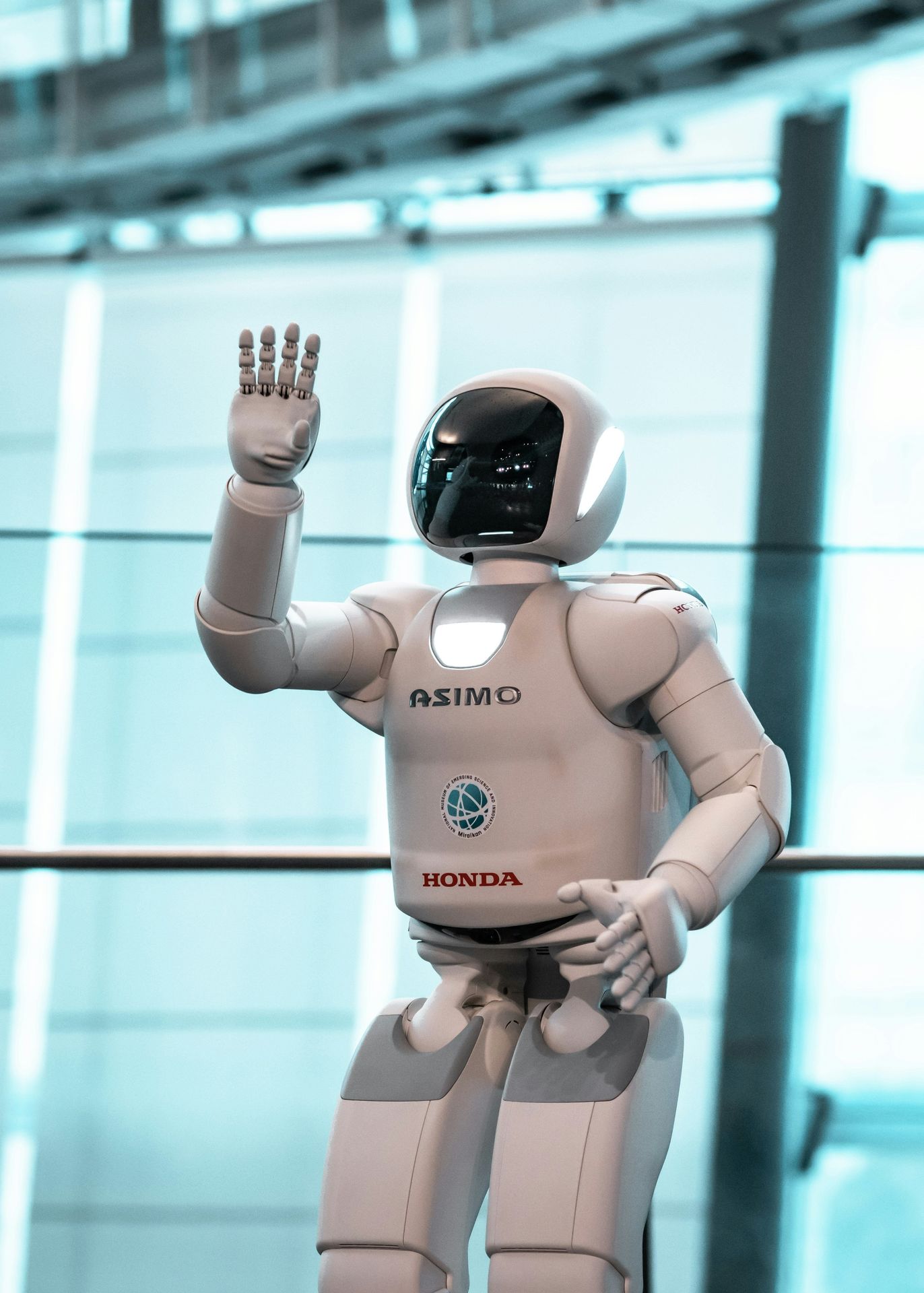
ASIMO, which stands for Advanced Step in Innovative Mobility, is a humanoid robot created by Honda in 2000. It is displayed in the Miraikan museum in Tokyo, Japan. ASIMO can walk independently, climb stairs, recognize faces and emotions, and interact with people through speech and gestures.
ASIMO was designed to be a mobility assistant robot that can operate in a living environment with people. However, in 2018, Honda announced that it would cease the commercial development of ASIMO, and focus on more practical applications using the technology developed through ASIMO's lifespan.
Pepper by Softbank Robotics
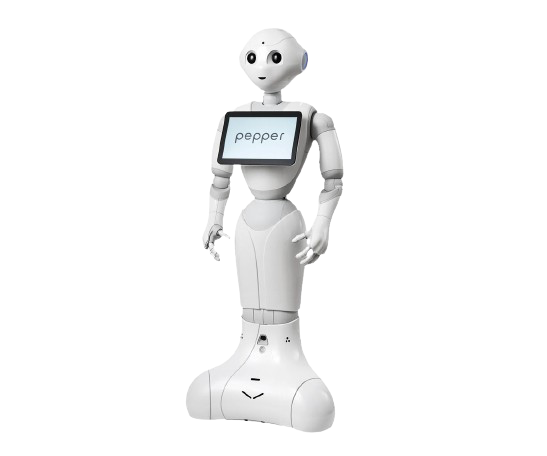
Pepper is a helpful robot that can help customers, answer questions, and make special experiences in different industries. A French robotics company called Aldebaran Robotics created Pepper, which SoftBank Group bought in 2015.
Pepper is equipped with cameras, sensors, artificial intelligence, and natural language processing. It can recognize faces, emotions, and speech, and adapt to different situations. Pepper is used for service, entertainment, education, and research purposes.
As of 2020, over 15,000 units of Pepper have been sold worldwide.
NAO by Softbank Robotics
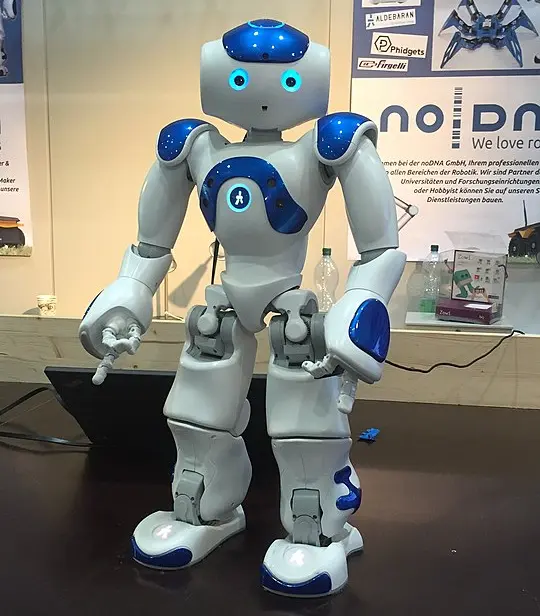
NAO is a small humanoid robot that can perform various tasks and functions. NAO was the first robot created by Aldebaran Robotics in 2006, and is now owned by SoftBank Robotics.
NAO can speak more than 20 languages, move naturally, and sense its environment. It can also learn from its interactions and experiences.
NAO is used for education, research, and entertainment. It can inspire students, improve teamwork, and increase interest and knowledge of STEM skills.
G1 by Unitree
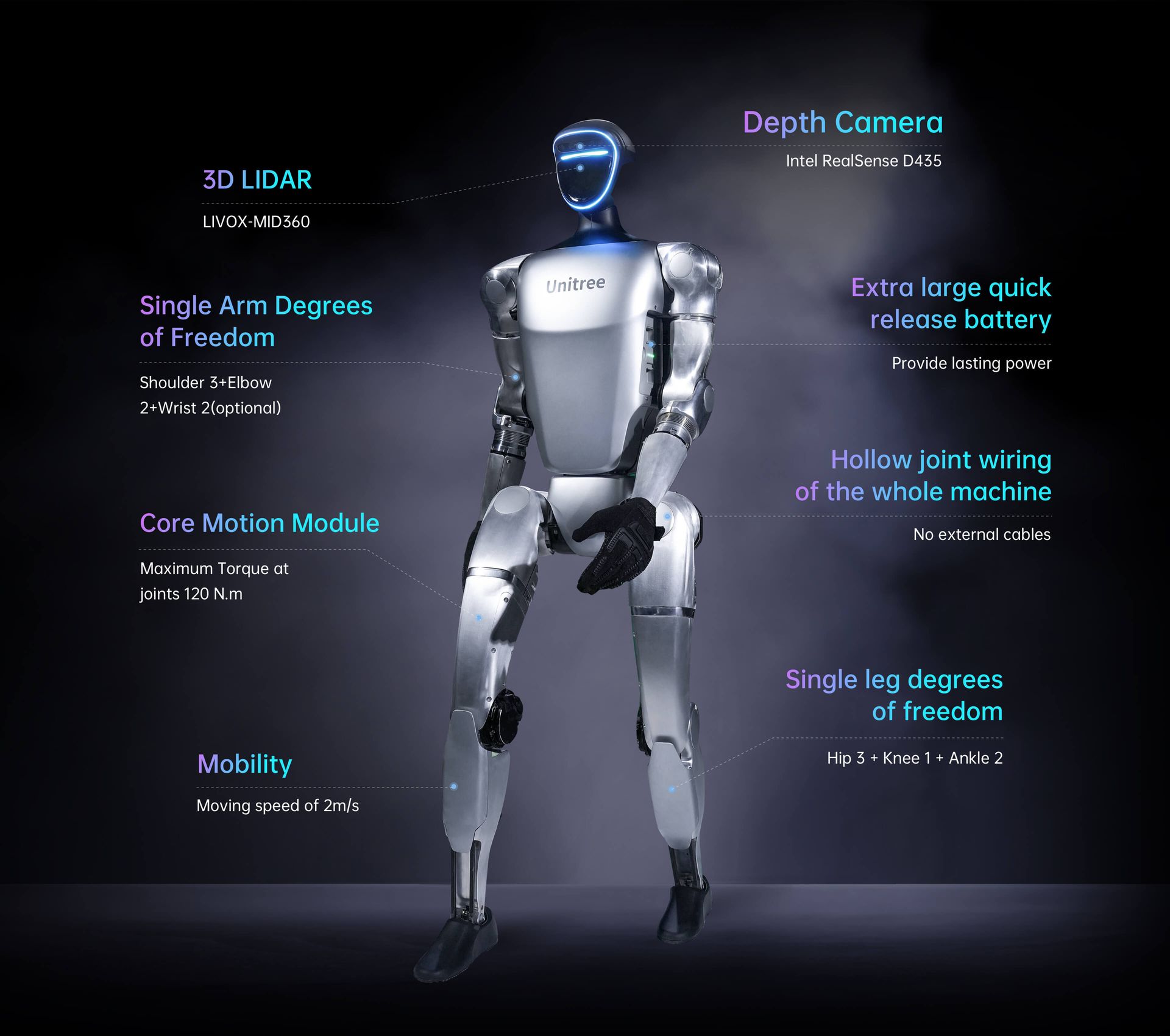
The G1 is a humanoid agent AI avatar, remarkable in its ability to imitate and learn from human behaviors. Developed by Unitree Robotics, an innovative Chinese robotics company, in the year 2024, G1 represents the forefront of robotic agility and adaptability. It boasts a range of 23 to 43 joint motors, equipped with force control dexterous hands, and an impressive 360-degree perception capability.
This avant-garde creation excels in performing operations that demand high flexibility and precision. Tasks such as sorting colored blocks, precisely locating its limbs in space, and maintaining a yoga pose are executed with remarkable accuracy. The G1's capabilities are powered by a tailor-made battery and a 12-core high-performance CPU. Vision is granted through advanced technologies including a depth camera and 3D LiDAR, allowing G1 to perceive its surroundings with exceptional clarity.
Designed for interactive human engagement, G1 heralds a new era of intelligence, opening up myriad possibilities for the future of humanoid robotics.
Optimus by Tesla
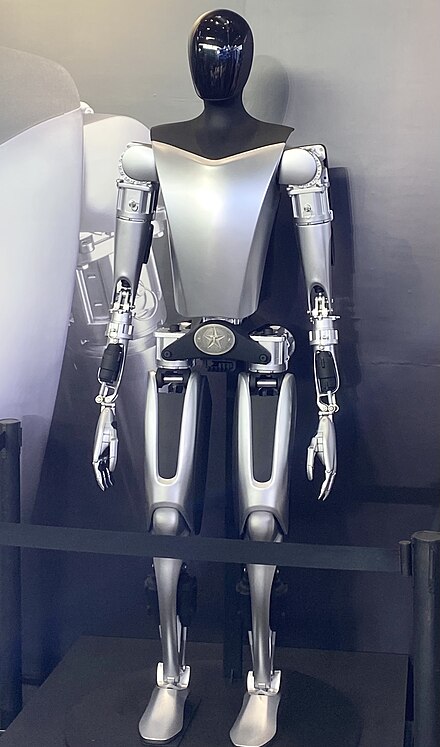
The Optimus, also renowned as the Tesla Bot, is a general-purpose robotic humanoid engineered to undertake tasks humans would rather avoid. Announced by Tesla, the famed American electric vehicle and clean energy company, during its Artificial Intelligence (AI) Day event in 2021, with a prototype unveiled the following year, Optimus has been a subject of significant anticipation. Standing 5 ft 8 in (173 cm) tall and weighing 125 lb (57 kg), it is designed to blend seamlessly into human environments.
Optimus operates under the same advanced AI system that powers Tesla’s sophisticated driver-assistance systems, enhancing its functionality and efficiency. With a carrying capacity of 45 lb (20 kg), it is optimally designed to take over human labor in tasks that are dangerous, repetitive, or mundane — for instance, providing essential manufacturing assistance.
Impact on Society and Industry
Humanoid robots represent not just remarkable feats of technology but also serve as dynamic agents of transformation within our society and industries. This section delves into their current applications and their profound impact on various sectors including healthcare, industry, education, and the workforce.
Humanoid Robots in Healthcare
During the COVID-19 pandemic, the relevance of humanoid robots in the medical field has soared, serving in roles ranging from telemedicine and remote care to cleaning, sanitization, and patient support. They've been pivotal in supply delivery, medication distribution, screening procedures, temperature checks, and in bolstering public health awareness and education.
These robots also hold the potential to significantly enhance patient care, particularly for the elderly, disabled, or those with chronic conditions, by providing companionship, emotional support, cognitive enrichment, and physical rehabilitation. They aid healthcare professionals with tasks that are either mundane, perilous, or necessitate exceptional precision, such as surgeries, diagnostics, and patient rehab.
Nonetheless, the integration of humanoid robots in healthcare raises ethical and social considerations, including concerns about privacy, accountability, trust, and preserving human dignity.
Humanoid Robots in the Industry
Various industrial domains, including manufacturing, logistics, construction, and agriculture, are now deploying humanoid robots to leverage benefits like improved efficiency, quality, safety, and adaptability. These robots excel in performing in environments that are either hazardous or detrimental to human health, managing heavy or fragile items, and executing intricate or monotonous tasks.
Moreover, they facilitate human-robot collaboration, augmenting human capabilities or substituting human intervention in certain tasks, thus reshaping workforce dynamics. Nevertheless, this transition also prompts questions on employment, skill requirements, compensation, and social inequality.
Education and Research Enhancement
Humanoid robots emerge as formidable allies in education and research, enhancing learning in STEM, languages, arts, and social sciences. They provide personalized support, motivation, and engagement, enriching the educational experience.
These robots also assist educators and researchers by serving as platforms for experimentation, data collection, and demonstration of new pedagogical techniques and technologies, thereby contributing to academic innovation. However, their use also accompanies pedagogical and ethical dilemmas related to curriculum integrity, evaluation methods, and the nature of human-robot interactions.
Human-Robot Interaction and the Future of Work
Far from being mere automated tools, humanoid robots act as social participants within various settings, paving the way for a new era of human-robot interaction. This emerging field explores the dynamics of communication, collaboration, and coexistence between humans and robots, shaping both the present and future of our workplaces.
This interaction holds promise for enhancing performance and wellbeing among both humans and robots, offering new career paths, skills, and confronting us with unique challenges and ethical considerations. Thus, designing, regulating, and assessing human-robot interaction demands meticulous attention to ensure it serves the best interests of society and leads to sustainable outcomes for all involved.
Challenges and Ethical Considerations
The introduction of humanoid robots into human society brings forth a myriad of challenges and ethical considerations. This section will delve into some of the critical issues associated with their integration and propose ways to address them.
Ensuring humanoid robots are designed to cause no harm to humans or other beings presents not just a technical obstacle but a moral imperative. This principle of nonmaleficence, or the ethic to "do no harm," is crucial for robot designers, as highlighted by Hutler et al. Robots must be programmed to identify and steer clear from potential dangers in their surroundings, actively working to minimize risk.
This necessitates a clear definition of the robots' scope of responsibility, including the extents of harm prevention. Critical questions arise: Should robots be accountable for their actions, and how? Is it essential for robots to prioritize the well-being of humans over animals, or should there be an equilibrium? And, should they intervene in human disputes or respect our autonomy?
Another significant challenge is finding the right balance between the benefits humanoid robots bring and the potential costs of substitifying human connections with robotic interactions. These machines may offer convenience and efficiency, yet they also risk undermining human dignity, identity, and the fabric of society. Etemad-Sajadi identifies six ethical concerns regarding service robots: privacy, trust, social interaction, autonomy, responsibility, and the implications of labor replacement.
Such concerns spotlight the impacts of humanoid robots on fundamental human rights and emotions. For instance, how do we ensure robots honor our privacy and data? Can we trust them to be safe and not to cause harm, whether by error or design? What about the emotional impact of engaging with robots that mimic human behavior and expressions? Moreover, how do we maintain our autonomy and prevent over-reliance on robots?
Distributing responsibility for robots' actions to avoid moral disengagement, and addressing the socioeconomic effects of robots taking over human jobs, are also pressing challenges—highlighting the need to navigate potential outcomes like unemployment and social inequality thoughtfully.
A final hurdle is ensuring humanoid robots' compatibility with human values and societal norms. As social participants, robots must adhere to ethical guidelines that govern human interactions. Nagenborg et al. discuss the importance of defining robots' moral status and the human duties towards them. What rights should they have, and how should humans interact with them? It's also vital to develop robots that align with human values across various cultures and contexts.
Riek et al. suggest the creation of a code of ethics for human-robot interactions, stressing the need for ethical design principles in robot development. Ensuring robots are fair, transparent, and accountable, and that they behave in ways that are respectful, culturally sensitive, and non-discriminatory, is essential for a harmonious coexistence.
Conclusion
In this article, we've delved into the captivating realm of humanoid robots, touching upon their features, applications, and influences. We've observed their technological and intelligence advancements, alongside their integration into various sectors including healthcare, industry, education, and the workforce. Additionally, we've tackled some challenges and ethical dilemmas, such as safety, privacy, trust, responsibility, and compatibility, which accompany the creation and utilization of humanoid robots.
Importantly, humanoid robots transcend mere mechanical boundaries to become social entities that interact with humans in numerous ways. This necessitates a keen awareness of the advantages and potential hazards of humanoid robotics, ensuring they are crafted and operated in manners that are beneficial, ethical, and sustainable for both humans and robots alike.
For those keen to dive deeper into the world of humanoid robots, various sources cited in this article await your exploration. Additionally, visiting websites of notable humanoid robot developers and researchers may enrich your understanding. Watching videos showcasing humanoid robots in action offers a glimpse into their remarkable capabilities. Feel free to express your viewpoints on humanoid robots with us, or engage in discussions with friends and family.
We trust that you've found this exploration enlightening and entertaining, broadening your perspective on the dynamic field of humanoid robots.